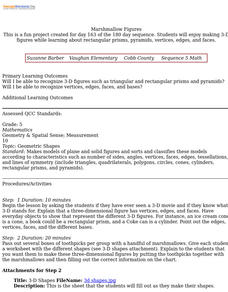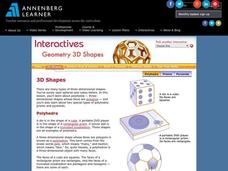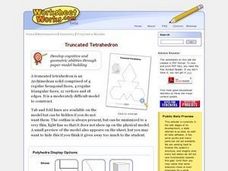Curated OER
Practice Exam Part 1: Vocabulary
In this geometry worksheet, students practice constructing a variety of graphs with various degrees of vertices. Students determine whether 12 graphs have an Euler circuit or path.
Curated OER
3-D Attributes
Learners explore geometric solids. In this geometry activity, students listen to the book The Greedy Triangle by Marilyn Burns, then work in groups to sort geometric solids into various categories. Learners define geometric solids...
Curated OER
Marshmallow Figures
Learners enjoy making 3-D figures while learning about rectangular prisms, pyramids, vertices, edges, and faces. After a lecture/demo, students use marshmallows, toothpicks and a worksheet imbedded in this lesson to create 3 dimensional...
Bowland
Geoboard Squares
Don't be a square! Help your budding mathematicians discover patterns within squares. Scholars create squares on geoboards and identify patterns in the number of nails, both nails on the edge of the squares and nails within the squares....
Annenberg Foundation
Geometry 3D Shapes: 3D Shapes
Explore vocabulary related to three-dimensional shapes. An instructional website describes the characteristics of different geometric solids. Learners can use an interactive component to view nets, faces, vertices, and edges of common...
Curated OER
Our Tangible World is Full of Dimensions
Sixth graders explore characteristics of two and three-dimensional figures. They observe the teacher demonstrate the faces, edges, vertices and names of specific figures. In groups, 6th graders examine and describe given figures. ...
Curated OER
Three-Dimensional Figures
Sixth graders explore three-dimensional objects. In groups, they create and decorate their own polyhedron design. After identifying the faces, vertices, and edges of the polyhedron, 6th graders determine a relationship between the...
Las Cumbres Observatory
How Big is the Solar System?
Find out if it's possible to travel to the edge of the solar system. Learners use a piece of string to model the distance between planets in the solar system. They then use the distances to calculate how long it would take to travel to...
Curated OER
Tetrahedron Kites
Let's go fly a kite! Discuss the concept of two-dimensional and three-dimensional objects with your math class. They examine a triangle and discuss the face, vertices, edges, and angles. Then they build their own Tetrahedral Kites and...
Curated OER
Cube Coloring Problem
Upper elementary and middle schoolers describe the various features of unit cubes, such as edges, corners, and faces. They also discuss how to represent measurements of a cube using exponents before engaging in various thinking and...
Curated OER
Create a Math Road Trip
Students create a Road Trip. They work in small groups. Students are given a road map for each group. They plan a road trip between two cities on opposite edges of the map, estimating a reasonable distance to travel each day. Students...
Curated OER
I've Seen That Shape Before
Learners identify geometric solids. In this shape lesson, students explore the characteristics of geometric solids. They locate pictures of shapes on the internet, and identify the shapes. Learners draw pictures of shapes, take...
Annenberg Foundation
Geometry 3D Shapes: Platonic Solids
From polyhedrons to platonic solids, here is a lesson that will have your classes talking! As an introduction to platonic solids, scholars cut and fold nets to create the three-dimensional solids. They use an interactive component to...
Illustrative Mathematics
Computing Volume Progression 2
Once your geometers know how to apply the formula V = l w h, they will be ready to take on the fractional volume of a fish tank. Have your number crunchers swap heights so they can see that the fractional volume will not change.
Curated OER
Toothpicks, Gumdrops, and Polyhedrons
Sixth graders use toothpicks and gumdrops to make prisms and pyramids. This helps them explore the relationship betweeen faces, vertices, and edges.
Curated OER
Edible Geometry
Students examine a chart that lists the main characteristics of polygons and 3 dimensional figures. They make examples of the polygons and figures using pretzels and gum drops showing how the gum drops are vertices and the pretzels are...
Curated OER
N Equal Parts by Construction
Students experiment with straight edges and compasses to divide lengths into equal parts. They identify different fractions of the total length.
Noyce Foundation
Cutting a Cube
Teach the ins and outs of the cube! A series of five K–12 level activities explore the make-up of the cube. The beginning lessons focus on the vocabulary related to the cube. Later lessons explore the possible nets that describe a cube....
Curated OER
Exploring Area and Perimeter
Two students are blindfolded and each receives a cardboard square, one with pompoms glued around the edge and one with pompoms glued all over the surface. They identify what they feel. The class discusses perimeter and area of polygons....
Math Mammoth
Construct Line Segments and Angles
In this math worksheet, learners are asked to used a compass and straight edge to construct copies of shapes, angles and line segments.
Curated OER
Making/Building Kites
Learners explore kite making. In this cross curriculum fine arts and ancient Chinese history lesson, students activate prior knowledge about how kites were used in ancient Chinese culture. Learners sketch an original kite design, then...
Curated OER
Identifying and Classifying Solid Figures
Students identify solid figures. In this classification lesson, students recognize and name solid figures. Students identify which figures contain polygons and rectangles. Students practice counting vertices, faces and edges.
Curated OER
Pyramids & Prisms: Guler's Formula
Sixth graders compare and contrast two-dimensional shapes to three-dimensional shapes. After watching a demonstration, they make their own shapes using nets printed on paper. To end the activity, they use the shapes they made and...
Curated OER
Truncated Tetrahedron
In this math activity, learners read about the truncated tetrahedron and then create a paper model. It should look like a solid comprised of 4 regular hexagonal faces, 4 regular triangular. faces, 12 vertices and 18 edges.

























